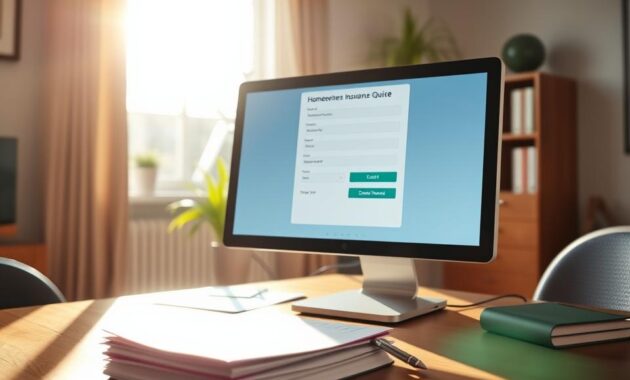Protecting your home and financial security is key. The right homeowners insurance coverage is essential. With many options, finding the best home insurance quote can be tough. But knowing the value of a good homeowners insurance quote is the first step to protect your assets.
The right coverage shields your home from unexpected damages. It also gives you financial security in case of accidents or natural disasters. By comparing different insurance providers and policies, you can find the best quote that fits your needs and budget.
Key Takeaways
- Understanding the importance of homeowners insurance is key to protect your home and financial security.
- Comparing different insurance providers and policies helps you find the best homeowners insurance quote.
- The right coverage protects your home from unforeseen damages and provides financial security.
- Assessing your insurance needs and budget is essential for choosing the right policy.
- A good homeowners insurance quote can provide peace of mind and financial protection.
Understanding Homeowners Insurance Coverage
It’s important to know what your homeowners insurance covers. This type of insurance helps protect your home and your money. It acts as a safety net against unexpected events.
Types of Coverage Included in Standard Policies
Standard policies usually have a few key coverages. Dwelling coverage protects your home’s structure. Personal property coverage looks after your belongings. Liability coverage helps if you’re sued for injury or damage you cause.
Optional Coverage Add-ons Worth Considering
There are extra protections you might want to add. For example, flood insurance or earthquake insurance are important in certain areas. These can give you more peace of mind and financial security against disasters.
Coverage Limits and Deductibles Explained
It’s vital to understand coverage limits and deductibles. Limits show the max your insurer will pay for a loss. Deductibles are what you pay first before insurance helps.
“A higher deductible can lower your premium, but you’ll pay more in the event of a claim.”
Finding the right balance between these can help you manage your costs.
Factors That Affect Your Homeowners Insurance Quote
Your homeowners insurance quote depends on several factors. These include your home, personal details, and what coverage you choose. Knowing these can help you lower your insurance costs.
Home-Related Factors
Your home’s features greatly affect your insurance quote. Important factors include:
- Location: Homes in areas with natural disasters or high crime rates cost more to insure.
- Age and Construction: Older homes or those prone to damage may have higher premiums.
- Construction Type: The material of your home, like brick or wood, can also affect rates.
Personal Factors
Your personal details are also key for insurers. This includes:
- Credit Score: A better credit score can mean lower insurance costs, showing you’re financially responsible.
- Claims History: If you’ve filed many claims, your insurance might be more expensive.
Coverage Choices
The coverage you pick and your deductible amount matter a lot. Choosing higher coverage or lower deductibles can raise your premium. But, picking a higher deductible can lower costs but means you’ll pay more if you make a claim.
Understanding these factors can help you save on homeowners insurance. For example, improving your home’s security or keeping a good credit score can lead to better rates.
Top Homeowners Insurance Providers in the US
The US market has many homeowners insurance providers. But some are better than others. Look at coverage, price, and customer service when choosing.
State Farm
Overview
State Farm is a big name in home insurance companies. They have lots of coverage options.
Pros
- Extensive agent network
- Variety of coverage options
- Discounts for bundling policies
Cons
- Premiums can be higher than average
- Customer service ratings vary
Features
State Farm has innovative features. They offer smart home discounts and a user-friendly app.
Allstate
Overview
Allstate is a big insurance provider in the US. They are known for good prices and wide coverage.
Pros
- Competitive pricing
- Wide range of coverage options
- Discounts for safe driving and home security
Cons
- Customer service can be inconsistent
- Rate increases upon renewal
Features
Allstate has unique features. They have the Drivewise app for tracking driving habits.
Liberty Mutual
Overview
Liberty Mutual is a well-known homeowners insurance company. They offer many coverage options.
Pros
- Customizable coverage
- Discounts for new homes and home improvements
Cons
- Higher premiums for older homes
- Limited availability in some areas
Features
How to Get a Homeowners Insurance Quote Online
Getting a homeowners insurance quote online is easy and fast. Insurance companies have made it simple for homeowners to get quotes from home. This saves time and effort.
Simplifying the Online Quote Process
First, visit an insurance company’s website or an online marketplace. Here, you can compare different quotes. You’ll answer questions about your home and personal info.
Key Steps:
- Enter your property details, including location, size, and construction type.
- Provide information about your personal insurance history and credit score.
- Choose your desired coverage limits and deductible.
Information Required for an Accurate Quote
To get a precise quote, you need to share specific details. This includes:
- Property address and type (e.g., single-family home, condominium).
- Year built and any significant renovations.
- Square footage and number of rooms.
- Any safety features, such as a security system or smoke detectors.

Timeline for Receiving Your Quote
The time it takes to get a quote varies. It depends on how complex your request is and the insurer’s system. Usually, you’ll get your quote in minutes to hours.
Tips for a Smooth Experience:
- Have all necessary information ready before starting the quote process.
- Double-check your entries for accuracy to avoid delays.
- Consider contacting the insurer directly if you have complex needs or questions.
Comparing Homeowners Insurance Quotes Effectively
With many insurance providers out there, comparing homeowners insurance quotes is key. It’s important to understand what you’re comparing to make a good choice.
Creating a Standardized Comparison Spreadsheet
One good way to compare is by using a spreadsheet. This helps you look at different parts of each insurance quote side by side.
| Insurance Provider | Premium Cost | Deductible | Coverage Limit |
|---|---|---|---|
| State Farm | $1,200 | $1,000 | $300,000 |
| Allstate | $1,500 | $500 | $250,000 |
| Liberty Mutual | $1,300 | $1,500 | $320,000 |
Beyond the Premium: Evaluating Coverage Details
The cost of the premium is important, but it’s not everything. You should also look at the deductible and coverage limits.
“The cheapest policy is not always the best. It’s essential to balance cost with coverage.”
Questions to Ask Insurance Agents
When comparing quotes, ask insurance agents specific questions. This helps clear up any confusion about the policy terms.
- What is covered under the policy?
- Are there any exclusions or limitations?
- How does the deductible impact my premium?
Discounts and Savings Opportunities for Homeowners Insurance
Homeowners can cut their insurance costs by looking into discounts and savings. Insurance companies offer many discounts to lower premiums.
Common Discounts Offered by Insurers
Many insurers give discounts for security systems, being a non-smoker, or no claims history. Bundling multiple policies with the same company can save a lot.
Home Improvement Investments That Lower Premiums
Improving your home with storm shutters or reinforced roofing can lower insurance costs. These upgrades make your home more resistant to damage, reducing insurer risk.
Bundling Options and Multi-Policy Discounts
Getting home and auto insurance from the same company can save money. It also makes managing insurance easier.
| Discount Type | Average Savings |
|---|---|
| Security System Discount | Up to 20% |
| Bundling Discount | Up to 15% |
| Claims-Free Discount | Up to 10% |
Securing the Best Homeowners Insurance for Your Needs
Getting the right homeowners insurance quote is key to protecting your home and finances. It’s important to know what affects your premiums and how to compare quotes. This way, you can make smart choices.
Companies like State Farm, Allstate, and Liberty Mutual have different coverage options and discounts. You can lower your premiums by bundling policies, improving your home’s security, and keeping a good credit score.
To find the best homeowners insurance quote, shop around and compare coverage details. Ask the right questions. By following the tips in this article, you’ll get the coverage you need at a good price.
Stay informed and proactive to protect your home and assets. With the right home insurance, you’ll have peace of mind, knowing you’re covered against unexpected events.



